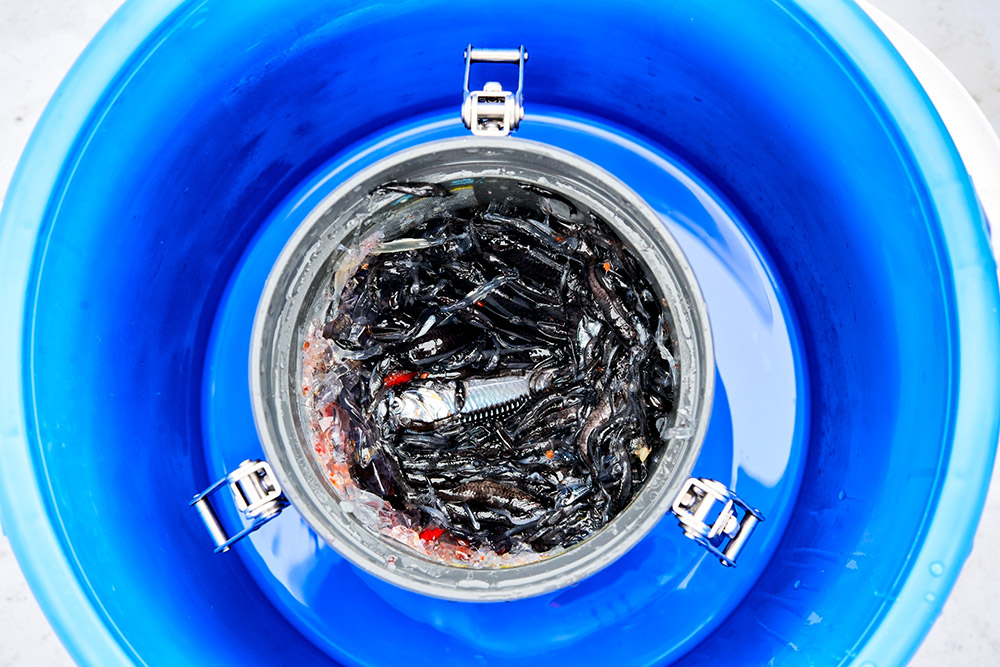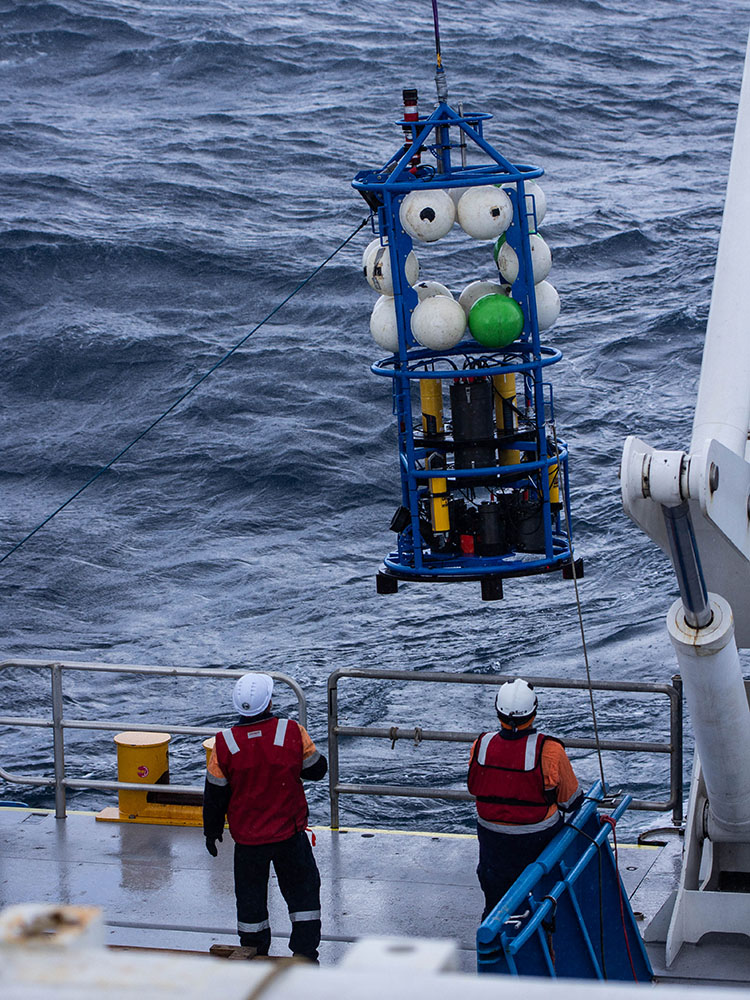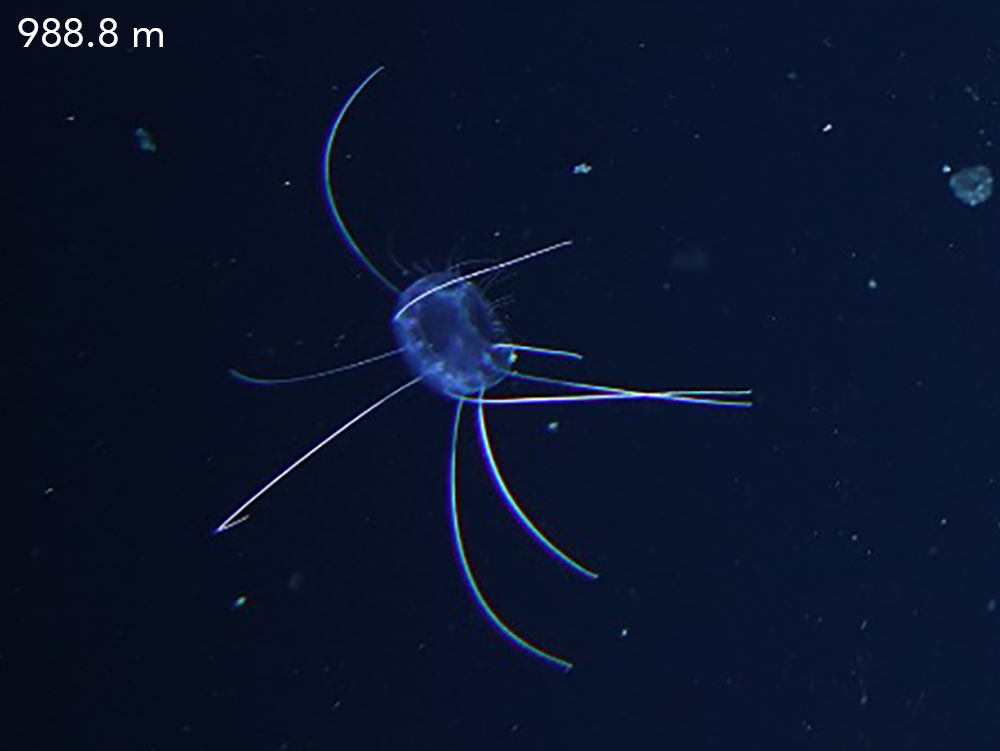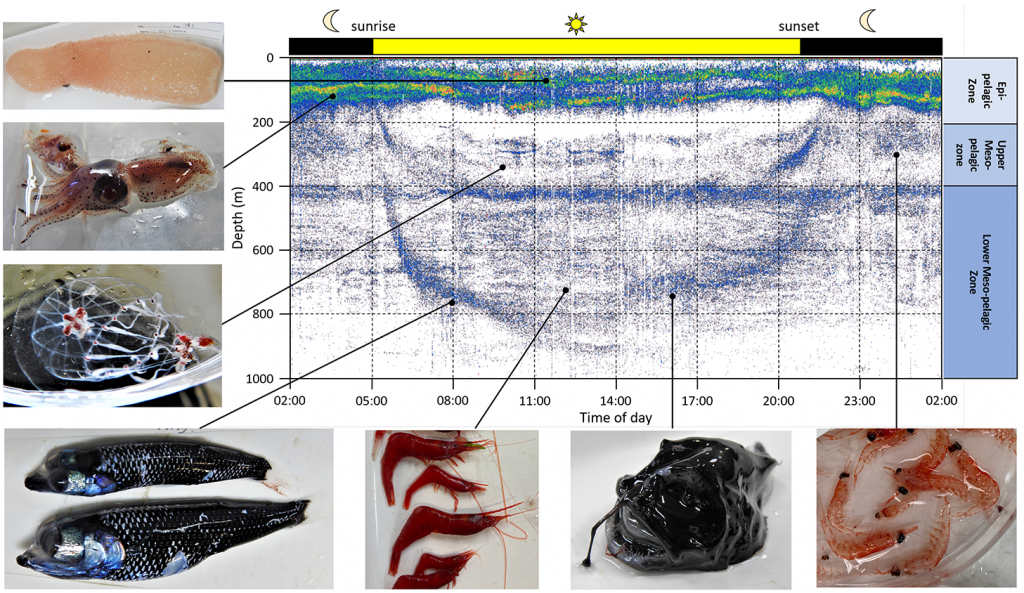Who’s who in the zoo? Micronekton of the Southern Ocean
Katy Baker
IMAS Research Assistant
What are micronekton?
Micronekton are free-swimming pelagic animals around 2-20 cm in size and make up an important trophic link in the marine food web. However, understanding their community composition at varying depths and time of day is no easy task. Researchers aboard the RV Investigator are using a combination of sampling techniques to take on this challenge and ask “who’s who” in the micronekton zoo?
The role of micronekton in the carbon cycle of the ocean
A large proportion of the micronekton community undertakes daily vertical migration (DVM) where they move from the deep, dark mesopelagic zone (400-1000 m) to the epipelagic layer (0-200 m) at night to feed. Although, not all individuals of a species may take part in this migration. The smaller members of the micronekton community (e.g. krill and amphipods) feed on carbon rich algae close to the surface, whilst the larger species (e.g. pelagic fish and squid) feed on these smaller micronekton before returning to the dark depths during the day. As well as making a tasty meal for larger animals in the twilight zone (a 200-1000 m layer of water just beyond the reach of light), micronekton are important transporters of atmospheric carbon from the surface layers of the ocean to the deep. They contribute to this transport of carbon by feeding in the shallows and pooing in the deep. It is important for researchers to understand the number of individuals and the range of species undertaking this daily migration to gain a better understanding of their role in the carbon cycle.
How do we sample the micronekton community?
On the SOLACE voyage we are sampling micronekton using three different methods (1) trawl nets, (2) acoustics and (3) cameras. Each of these methods has its trade-offs and each tells a slightly different story of what lies below the waves. We hope that by using these different samplers we’ll be able to provide a more complete picture of the micronekton community in the Southern Ocean.
The Rectangular Midwater Trawl
The Rectangular Midwater Trawl (RMT) is a 16 square meter rectangular trawl net designed to sample discrete depth layers. We deploy the net in a closed state and program it to open at a specific depth and to fish for a certain amount of time. Once at depth the net opens and is hauled back in at around 5 metres a minute. The net fishes diagonally up through the water column until the desired amount of time has elapsed. Upon reaching the maximum programmed time, the net closes and is winched slowly up to the surface in order to preserve the quality of the specimens. On the SOLACE voyage, we are using the RMT to fish three discreet depth layers (1) the lower mesopelagic zone from 1000-400m, (2) the upper mesopelagic zone from 400-200m and (3) the epipelagic zone from 200-0m. We will repeat this sampling requiem during both day and night throughout the voyage. Once the net is hauled up on deck, it is time to sort and identify the catch, which is where the fun begins! Sampling the micronekton with the RMT gives us a good indication of what micronekton species are found at different depths and if this changes between night, day and location.

The RMT about to be deployed off the RV Investigator. 📷 Caroline Sutton 
The cod end with catch from a trawl deployment waiting to be sorted. 📷 Robert Strzepek.
The PLAOS
On the SOLACE voyage, we are deploying a novel piece of equipment called the profiling lagrangian acoustic optical system (PLAOS). The PLAOS is equipped with a number of cameras and acoustic sensors pointing in different directions. As the PLAOS profiles the water column from the surface to a depth of 1000 m these systems collect high-resolution acoustic data and photos.
Since animals captured in the trawl nets often lose their colour and shape (e.g. jellyfish), the PLAOS photos give us a rare opportunity to peak into the depths to see what these creatures really look like! We can also determine the exact depth which the photo was taken and build a better idea of where different animals hang out in the water column during the day and night. The PLAOS data will complement ship-based acoustics and trawl net samples to provide us with a greater understanding of the micronekton community in the Southern Ocean and the role they play in transport of carbon to the deep.
While trawl net sampling allows for higher taxonomic identification (e.g. down to species level), acoustic data provide a better description of the distribution and abundance of broad taxonomic groups (e.g. fish, jellyfish and crustaceans) through the water column. Acoustic instruments (i.e. echosounders) periodically (about 5 times a second in our case) transmit sound into the water column. When this sound hits a target in the water column (e.g. fish or squid) some of it is reflected back to the echosounder as an echo. These echoes are then visualised as an echogram. The strength of an echo at different acoustic frequencies can help us to discriminate between different targets. For example, a fish with a swim bladder will reflect more sound than a jellyfish which is mostly made up of water. As the PLAOS profiles the water column the acoustic systems onboard continuously collect information on the types of targets and the number of targets at different depths. We can use this information to provide a detailed description of distribution and abundance of different types of animals from 0-1000 m.

The PLAOS about to be deployed off the RV Investigator. 📷 Jake Weis 
A jellyfish captured by the PLAOS camera.
So, what have we found so far?
Preliminary results from the PLAOS and Rectangular Midwater Trawl net deployments highlight certain broad trends consistent with previous samples of Southern Ocean micronekton. Acoustic backscatter from the ship-based echosounders clearly show how the acoustic density (which can be used as a proxy for biomass) changes in the epipelagic zone (0-200 m) as animals migrate from the mesopelagic zone (400-1000 m) at night (see below image). This demonstrates the daily vertical migration that characterises micronekton behaviour. The catch from the trawl deployments show a similar pattern; catches at depth are larger during the day than at night, while catches from 200 m to the surface are larger at night than during the day.
While further analysis will reveal the most dominant animals migrating to the surface at night, the trawl catches and photos from the PLAOS so far certainly highlight the diversity of micronekton species at different depths!

While these early results are exciting, there is much more to come. With the addition of the higher resolution acoustic data and more photos from the PLAOS, the micronekton team aboard the RV Investigator will be close to understanding who’s who in the micronekton zoo!
Stay tuned….
Author: Katy Baker is a Research Assistant at the Institute for Marine and Antarctic Studies. She is currently looking at the effect of seismic activity on zooplankton.





